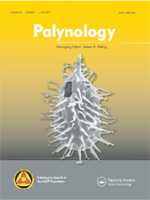Pollen grains from 16 species of Vernonanthura H. Rob. were studied. All the species exhibit the type ‘A’ pollen characteristic of the genus. These grains are spheroidal to prolate—spheroidal, subechinolophate, tricolporate, with a continuous tectum which is densely microperforate, exhibiting lophae surrounding irregular depressions and having prominent spines. Despite most of the species having a similar pollen type, some taxa can be recognised by the morphology of the spines. According to the spine index (length/width), the species analysed can be divided into three groups having respectively short, medium and long spines. In addition to the size of the spines, some taxa can be distinguished by spine shape. Vernonanthura pinguis (Griseb.) H. Rob. has spines which are constricted at the base, while V. oligactoides (Less.) H. Rob. exhibits small conical spines. Vernonanthura nudiflora (Less.) H. Rob. and V. schulziana (Cabrera) H. Rob. have spines with rounded apices. This study confirms that Vernonanthura is a well-defined group based on pollen characteristics and that pollen morphology is a significant feature in the characterisation of species and genera of Vernonieae.
How to translate text using browser tools
1 June 2011
Pollen Morphology of Some Species of Vernonanthura (Asteraceae, Vernonieae) from Southern South America
Alvaro José Vega,
Massimiliano Dematteis
ACCESS THE FULL ARTICLE
It is not available for individual sale.
This article is only available to subscribers.
It is not available for individual sale.
It is not available for individual sale.

Palynology
Vol. 35 • No. 1
June 2011
Vol. 35 • No. 1
June 2011
evolution
pollen
taxonomy
Vernonia




